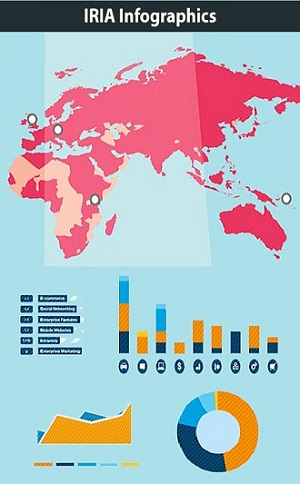By Dr. Gary K. Busch, July 5, 2017

In April 2017, the Russian Government announced that it had completed its new military bases in the Arctic and had completed most of the work on restoring several military bases in the region which had been abandoned. Russia is demonstrating its military potential in the Arctic Region and has repaired and replaced former port and military installations along its Arctic coast and developed new air bases on islands in the Arctic Seas. Defence Minister Sergei Shoigu highlighted the creation of a new Russian military base on Franz Joseph Land which will allow 150 troops to live continuously on its grounds for at least a year.
In addition to this facility, Russia has built a series of other military bases in the Arctic and North Pacific, including a slightly smaller base on Wrangel Island and a base on Cape Schmidt, the eastern coast of the Chukchi autonomous region.
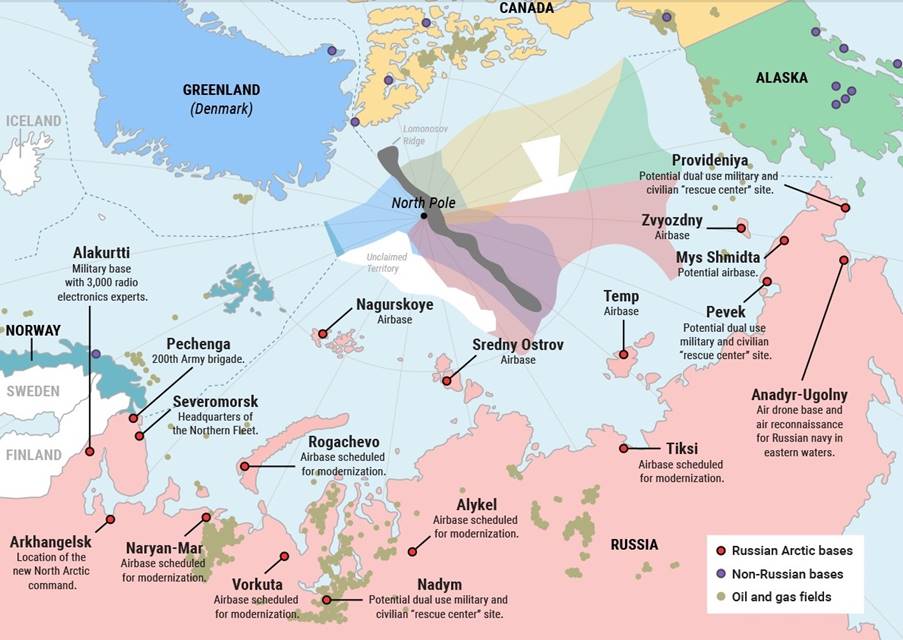
Russia and the Soviet Union have made a claim on the waters of the Arctic for centuries. Canada was the first to claim sovereignty over vast areas of the Arctic in 1925. This was followed by the Soviet Union in 1926 which claimed an area stretching from Murmansk, east to the Chukchi Peninsula and north, towards the North Pole including both the Mendeleev and Lomonosov Ridges. Other nations made claims on the region and the United Nations was pressed to establish some guidance on the competing claims.
In 1999, as part of the negotiations on the Law of the Sea, the UN adopted the United Nations Convention on the Law of the Sea (UNCLOS). The territorial claims of the competing parties had to be decided under the UNCLOS rules. The current status shows that the delineation has not been finally settled.
The current flurry of political and military activity in the Arctic derives from the spread of global warming in the region which has opened new shipping lanes and made access to the vast oil, gas and mineral reserves in the Arctic formerly too difficult to reach under the pack ice and glaciers.
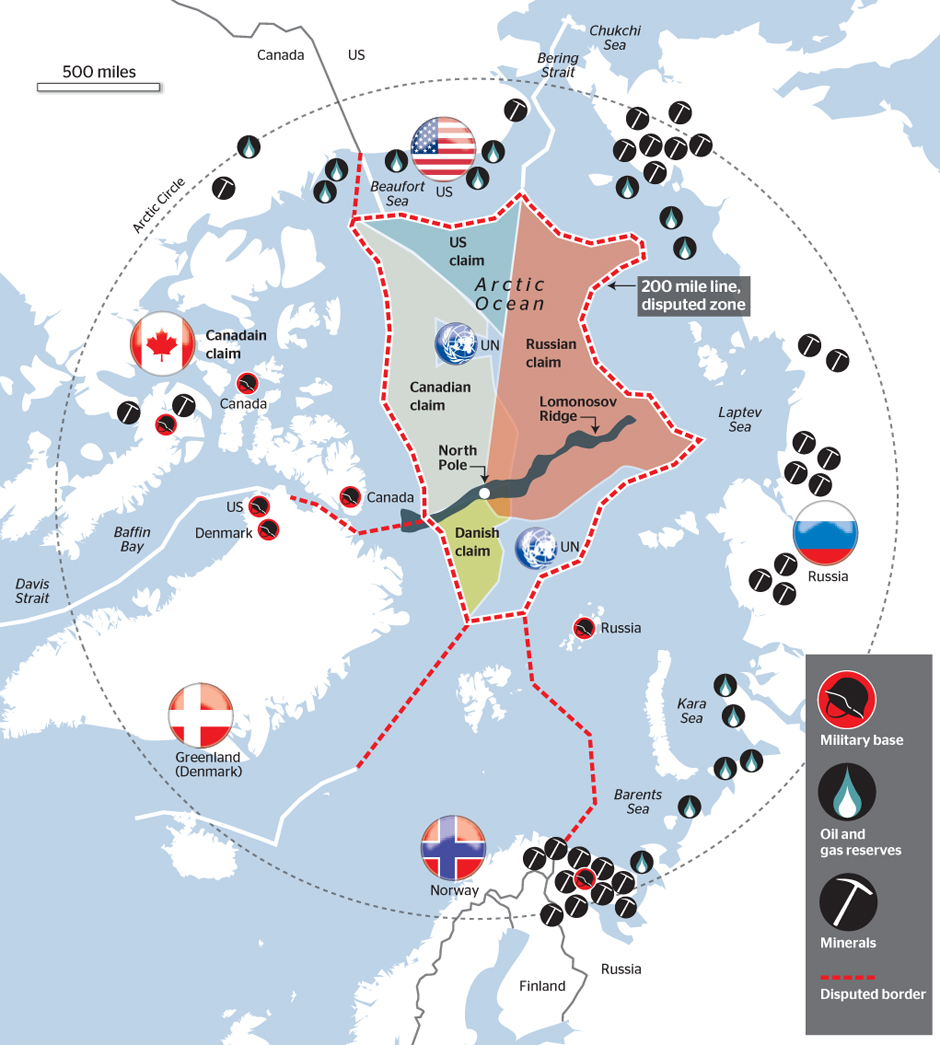
In 2001, in responding to the opportunities presented by climate change Russia applied to the UN for an extension of its Arctic territory on the basis that the Lomonosov Ridge might be considered an extension of the Siberian continental shelf and therefore allowing Russia to extend its claim in the region. The following year Russia sent expeditions in support of its claims and planted a Russian flag on the seabed in 2007. In addition, Russia began a program of re-militarisation with new bases and restoring former bases in the region.
Russia has also upgraded its docking facilities in Murmansk (one of its few ice-free ports) as a home for the new icebreaker vessels it is constructing. Existing air bases have been upgraded to improve coverage over the Arctic. Since 2015 Russia has equipped six new bases in the region, both on the mainland and on islands. These have included airbases on the islands of Franz Josef Land, Severnaya Zemlya, Wrangel Island, Kotelny Island and Novaya Zemlya. On the mainland, the facilities at Mys Shmidta, including the port and the airport, are also being upgraded.[i]
In addition, the Russian Navy has created a permanent base on Kotelny Island and, in 2016, it inaugurated its new facilities on Alexandra Land Islands. Moscow has deployed two long range S-400 regiments to Novaya Zemlya and the port of Tiksi alongside short range surface-to-air Pantsir-S1 systems to protect them. Arctic bases have also been reinforced with P-800 Oniks supersonic anti-ship missiles. The 99th Arctic Tactical Group has been permanently deployed to Kotelny Island and two other formations, the 200th Independent Motor Rifle Brigade and the 80th Independent Motor Rifle Brigade, have been converted into Arctic Brigades. Both formations appear stationed in the Murmansk Oblast and seem to be equipped with two-tiered tractors, snowmobiles and other vehicles, including the DT-30P Vityaz articulated track vehicle.[ii]
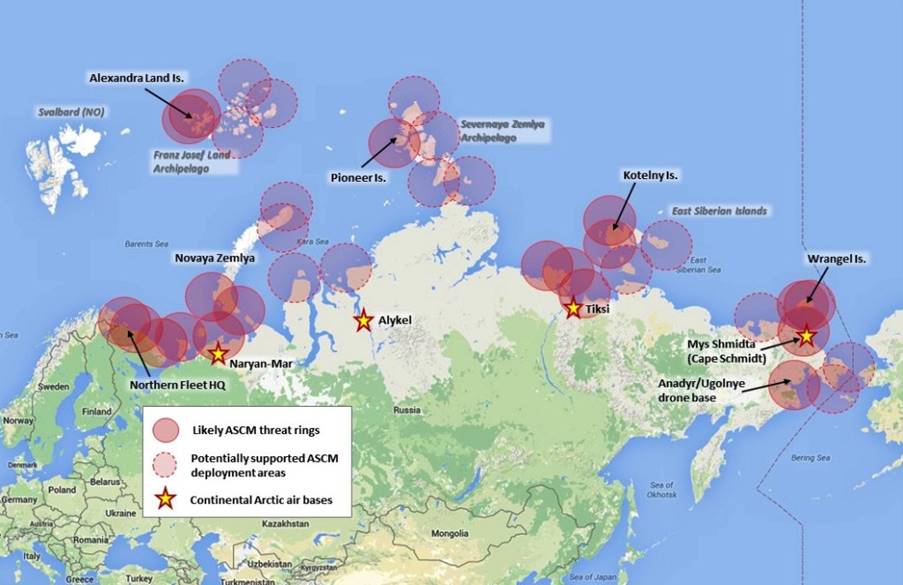
The Northern Sea Route
An important aspect of the opening up of the region as a result of climate change has been the decrease in the ice cover of the Arctic seas which allows for the transit of ice-class commercial vessels to pass through from Europe to Asia. This reduces the sailing time and allows for delivery of Arctic oil, gas and minerals to customers in both regions.
Russians have been interested in what was developing on the seas adjoining Siberia for a very long time. Siberia first came into the hands of the Muscovy tsars after the defeat of the khan, Kuchum, in 1582 by the Cossack, Yermak. In the late 1600’s a great walled trading town, Mangazeya, was established in the Arctic Sea to which England and Holland regularly sent merchant vessels to trade in the summer months when the water was free of ice. This arrival of foreign merchants soon frightened the Tsar who closed the port and the town and trade died. The town also traded with China through smaller vessels which plied the river route of the Yenisei; trade with Moscow was by ship from Archangelsk and the Kara Sea.
By the late 1700s the weather had changed again and the region remained frozen and blocked by pack ice. Few vessels ventured into Arctic waters or even along the Yenisei, Lena, Kolyma and Ob rivers. It wasn’t until 1879 that passage of the first ‘post-freeze’ vessel succeeded in making the Northern Route journey safely when the Finnish-Swedish explorer Adolf Erik Nordenskiöld reached the Bering Strait on board the steamer Vega, after having carried out a full passage from Europe, spending one winter along the way.
Although the development of the Northern Sea Route allows passage through the Arctic Seas, sometimes behind an ice-breaker, the littoral ports are often inaccessible for eight or nine months of the year by the locking in of the port by pack ice. One cannot ship safely from ports like Tiksi on the Lena after September 15 when the pack ice begins to form.
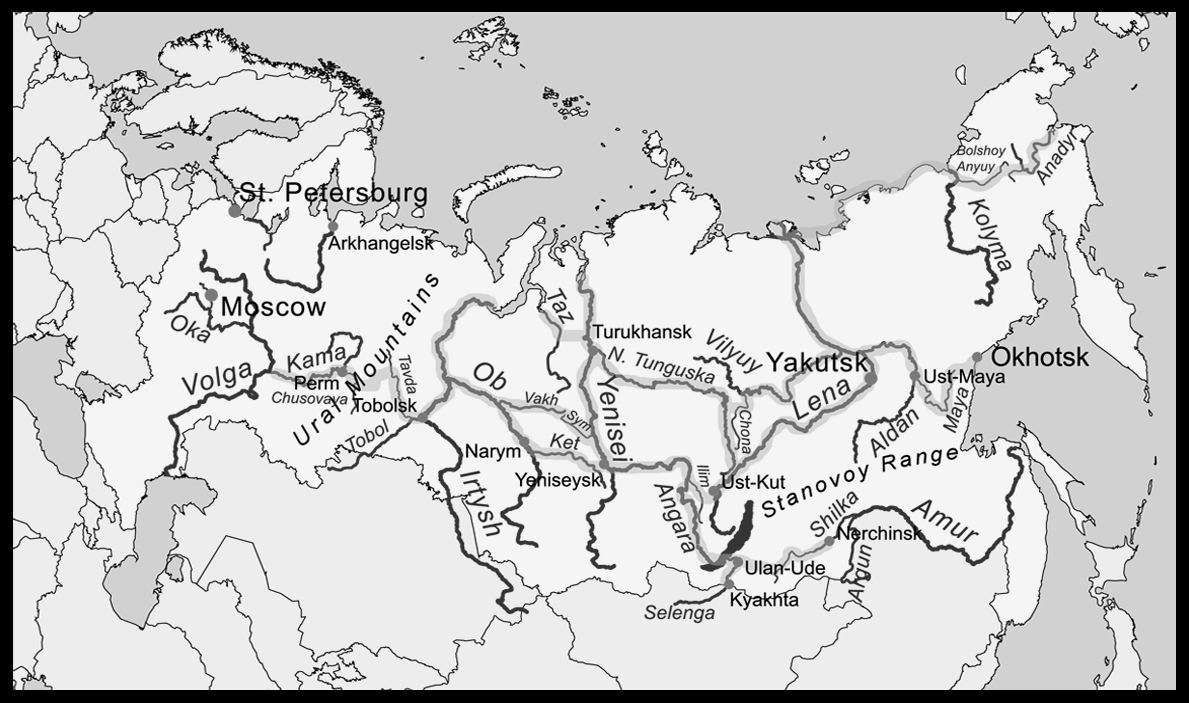
This Northern Sea Route allows a 5 to 7-day gain on the Suez Canal route to the Far East from the West and back.
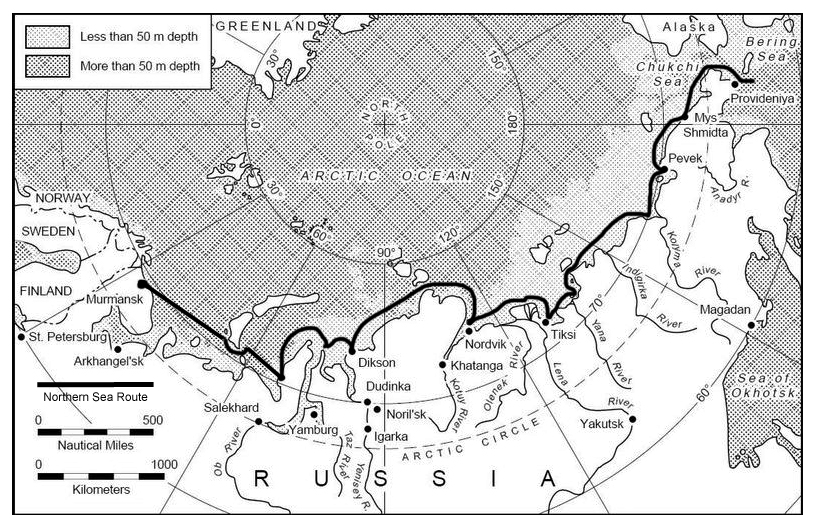
However, the development of the Northern Sea Route is peripheral for the growing interest in the Arctic. The major cause for Russia’s new attention towards control of the region has been major finds of subsea oil and gas which have attracted the attention of the world’s major oil companies.
Arctic Resources
The oil discoveries in the Arctic are at the heart of a new land grab by nations desperate to get their hands on this resource – including an estimated 90 billion barrels. Russia, Norway, the United States, Canada and Denmark all want a share of the seabed beneath the Arctic territory which is believed to also hold 30 per cent of the world’s untapped gas resources, according to the U.S. Geological Survey. Russian oil and gas companies have concentrated their activities on developing the resources of Siberia and the Arctic Seas.
In 2015 Gazprom Neft brought its second well into production at the Prirazlomnoye field, with output totaling 1,800 tons per day. This increased production by more than two-fold compared to 2014 production levels which stood at 300,000 tons. It was the first ever upstream project on the Russian Arctic Shelf, with a new type of oil, ARCO, launching on the international market in April 2014. The field is located in the Pechora Sea, 60 kilometres from shore. The Prirazlomnoye field was the scene of an environmental protest in the autumn of 2013 that saw 30 Greenpeace members arrested by Russia on charges of piracy.
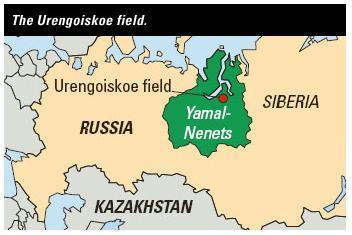
Despite the vast abundance of oil and gas in the region its economic success is far from settled for both climatic and political reasons. The Russian Arctic oil projects have suffered from the collapse in the world price of oil and from sanctions imposed on the Russians in the wake of the invasion of the Crimea. This has largely priced Arctic oil out of the market when shipping and delivery costs are included. The sanctions restrained the ability of large oil multinationals from passing on the new technology for oil drilling and the new shale oil technologies. Russia then concentrated on developing its large reserves of natural gas, especially in the Yamal project in the Yamal-Nenets autonomous district of northwest Siberia which extends roughly 700 km (435 mi) and is bordered principally by the Kara Sea, Baydaratskaya Bay on the west, and by the Gulf of Ob on the east.
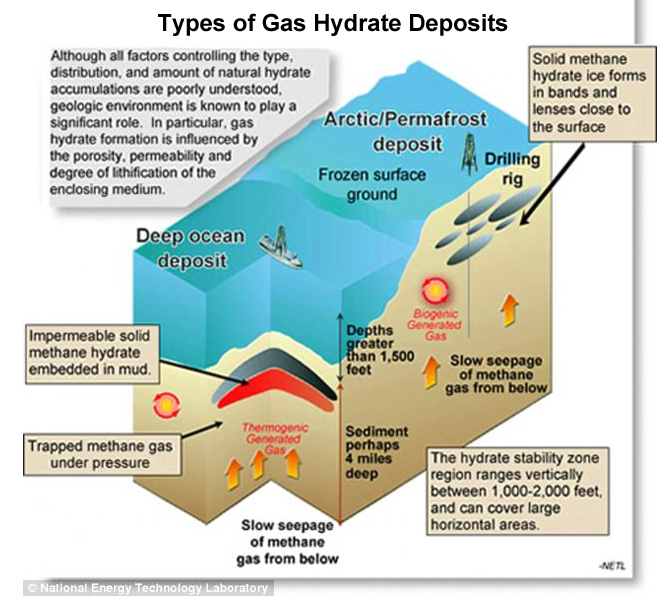
As the climate warms, more and more gas becomes available for exploitation; not only from the methane beneath the permafrost, but also from the reserves of methyl hydrates along the shores of the land mass in northern Siberia and around the Arctic islands. Methane hydrate is a compound in which a large amount of methane is trapped within a crystal structure made up of water, forming a solid that is similar to ice in its composition (although it looks like slush). With global warming, the retreat of the Arctic pack ice has made access to the marine deposits of permafrost much easier and attractive. Now, oil companies and the countries which have access to the Arctic are vying for the rights to explore this region for the commercial exploration of the vast methane reserves there. As the technology improves this struggle for rights to the methane will increase.
Although the Russians are not yet fully capable of exploiting the hydrate resources, the technology is far simpler than drilling in a cold climate. As the weather warms more of the submerged hydrates become accessible. To protect their interests and to prevent others from exploiting these resources the Russians have been resuscitating old Soviet bases in the area and preparing to man these bases with Russian troops.
The Threat To Resource Production in the Arctic
The Russians have far more to worry about than enemy nations interfering with their exploitation of these resources. The problem is that, as the Arctic warms, it is creating the conditions for a massive escape of subsea and sub-permafrost methane emissions. This has had a severe impact already, especially in the Yamal Peninsula. As global warming increases, the permafrost is melting and there is a major escape into the atmosphere of methane gas. In 2014, researchers discovered a giant sinkhole, or pingo, on the peninsula. This was a 60-metre crater caused by the build-up of excessive pressure underground of expanding methane bubbles because of warming. Soon they found many similar, if smaller, craters.
Researchers from the Norwegian Centre for Arctic Gas Hydrates (CAGE) believed this was created by a process called geothermal heat flux; the Siberian permafrost, which extends to the seabed of the Kara Sea, a section of the Arctic Ocean between the Yamal Peninsula and Novaya Zemlya, was thawing. According to CAGE, “The permafrost is thawing from two sides… [T]he interior of the Earth is warm and is warming the permafrost from the bottom up. It is called geothermal heat flux and it is happening all the time, regardless of human influence.” Methane is leaking in an area of at least 7500 m2. In some areas gas flares extend up to 25 m (82 ft). Prior to their research it was proposed that methane was tightly sealed into the permafrost by water depths up to 100 m (330 ft). Close to the shore however, where the permafrost seal tapers to a depth of as little as 20 m (66 ft), there are significant amounts of gas leakage.[iii]
This has affected mines as well as oil and gas installations. In February 2017, an explosion in the Severnaya coal mine, in Vorkuta, left four people dead and twenty-six stranded some eight hundred meters below the surface. Another explosion three days later killed six rescue workers and condemned to death the miners in the inaccessible shaft. This was only the most recent mine disaster at Vorkuta. In February 2013 nineteen miners had died and 3 more were injured in a methane explosion at Vorkutinskaya mine at Vorkuta.
As a result of global warming vast swathes of marshland in Siberia are starting to emit greenhouse gases thirty times more potent than carbon dioxide into the atmosphere. The threat comes from permafrost bogs around the size of mainland France which absorbed carbon dioxide over thousands of years before freezing over during the last Ice Age. Now for the first time in 11,000 years, the thick permafrost under these bogs is beginning to thaw rapidly and form lakes. Temperatures are rising twice the global rate in Russia’s coldest region because of warming, and this is likely to continue in the future.
Professor Oleg Anisimov, from the State Hydrological Institute in St Petersburg said: ‘The UN group of climate experts anticipate global temperature increase from two to four degrees Celsius by the end of the century. That is, warming here is two times faster than globally. This is because of the so-called Arctic amplification. There is a reduction in snow and ice cover, which reflect much of the coming sunlight. With less snow and ice, the Arctic gets additional warmth.[iv]
Some of the most important areas of Russian mining are being affected by the rise in temperature as the mines are located in the areas which are warming the most quickly. The areas around Norilsk, Vorkuta, the Komi Peninsula and the Sakha Republic are heating up relatively quickly and the resultant temperature rises are allowing the methane gases trapped since the second Ice Age in the frozen bogs of the tundra and taiga to bubble to the surface. The mines, especially those deep mines which operate at 700 to 900 metres underground are right near the point of conversion of methane from a solid to a gaseous state. It seems clear that this climate change will have to be addressed by a much stronger effort in the mines to protect the workers from explosions, tunnel collapses and fires.
This is equally true for the oil and gas industries which operate in the same regions.
The price of acquiring the Arctic resources is also the price of endangering the lives of all who work in the extraction industries and the mines. This is also a problem for the buildings sited on top of gas seepages and explosions. They have been damaged by the effects of these rising gases. Oil pipelines are being stressed by movements of the land under them which causes distortion of the lines and breaks in their transmission. There is a relatively high cost involved in dealing with these problems which the companies are unwilling or unable to pursue due to the drop in commodity prices, international sanctions and historic lack of concern for worker safety.
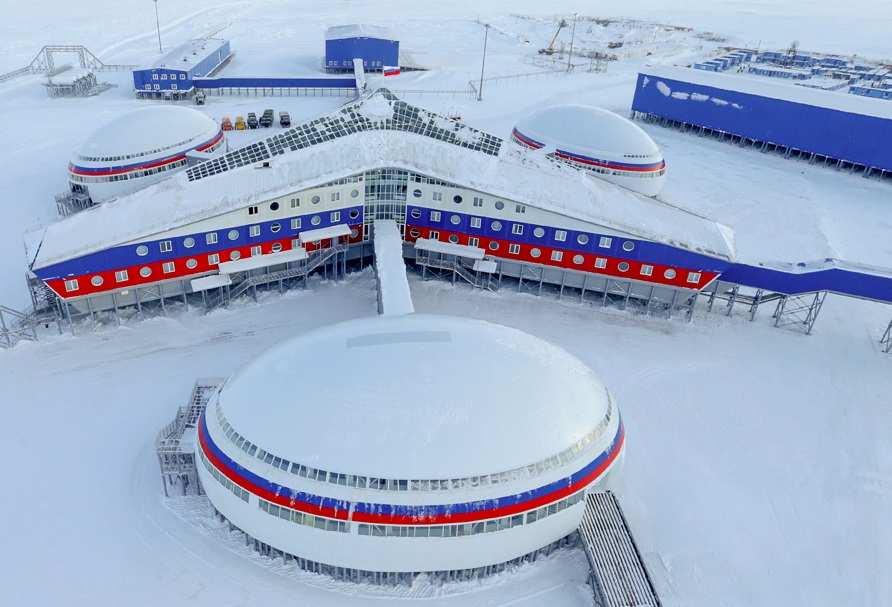
Logistics
By far the most difficult challenge to the Russian militarisation of the Arctic is the continuing problem of logistics. One of the key reasons for closing the Arctic bases in the late 1990s was the difficulties in delivering food and fuel to these bases. The airbases had not been maintained and there were not sufficient supplies of fuel at these bases to guarantee a return trip to the mainland without depriving the local aircraft with fuel to fly. While it was not too difficult to take Ice Class 3 vessels to the ports on the Kola Peninsula or Dudinka for most of the year, the other ports were often closed or the shore cranes weren’t working.
In the mid-1990s my company was involved in transporting goods to the Arctic bases for the Northern Fleet and the northern governors as we brought back aluminium, copper and nickel to Europe. The ports were in poor shape and many of the workers in the port had not been paid in months. There was little food or medicines and fuel supplies were low. Social services had all but collapsed. The Russians had a description for the state of the ports “Kolkhoz krasnaya lapas” (difficult to translate but close to ‘a place full of antiquated Communist technology’).
Bad as it was for the citizens of the cities and towns it was far worse for the inhabitants of the military bases as they had no money, no access to markets and were often in isolated spots or on islands where everything had to come in by ship; including food. They were also bored rigid with nothing to do. They were forced to improvise as I learned from a meeting with the Northern Fleet. We had been working with Anatoly Filatov (the last “Red Director” of Norilsk Nickel) and the Northern governors on a plan to deliver foodstuffs from Africa to the Arctic area. I asked how they were delivering the food themselves. The admiral told me that periodically they would take the missiles out of the tubes in the nuclear subs and fill the voids with potatoes. They would use the nuclear subs to deliver these potatoes to the isolated bases on the Arctic coast and the islands. He warned me that if there was a confrontation with a US submarine he would bombard the Americans with fresh potatoes.
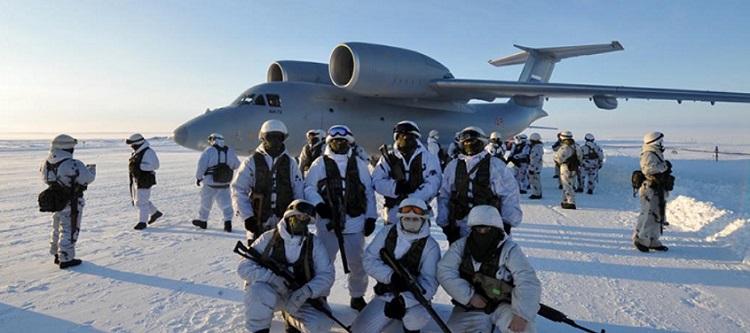
The Russian armed services were kept poor, underfunded, crowded and without much to do after Yeltsin took office. There were no jobs for all the returning officers from bases abroad and most of the ranks lived in squalor. Additionally, the recruitment or conscription of new soldiers was most effective among many of the ex-Soviet minorities. I was visiting the Northern Fleet when the admiral in charge of the large submarine fleet in Severomorsk told me that he was having nothing but trouble with many of the recruits he was being sent. He told me that they didn’t speak Russian very well (mainly Uzbeks, Tajiks, etc.). He said they couldn’t read the dials on the control displays on the nuclear subs so they had to put on stickers in their own languages to be sure they knew what they were doing. He said that if the tapes and the glue became dislodged from the dials then God only knows what button they would push.
There may have been many improvements in the conditions in the Arctic regions but it doesn’t seem very likely that they have improved sufficiently to maintain a functioning logistical trail for goods, parts, fuel, medicines and electrical supply in these remote areas. Manpower available in the region has declined dramatically. The supply of smaller, ice-class vessels is very limited. Shoigu has announced that notional money for the military upgrades will go on giant ice-breakers, high-tech weapons, missile and radar systems and submarines. That will not leave much available to feed, clothe and heat the people onshore or at the bases. Announcements of this type of logistical supply are rarely made.
It is difficult to imagine that the dangers of leaking methane emissions, spontaneous explosions of trapped methane pockets of subsurface gases, exploding coal and ore mines with trapped workers, and an insufficiency of non-military personnel in the ports is likely to pose much of a challenge to the rest of the world when the Arctic is re-militarised.
RESOURCES
[i] Steve Micaleff, CIMSEC, https://cimsec.org/russias-evolving-arctic-capabilities/30712
[ii] ibid.
[iii] Sojtaric, Maja (18 December 2014), Methane is leaking from permafrost offshore Siberia, Tromsø, Norway: Centre for Arctic Gas Hydrate (CAGE).
[iv] Anna Liesowska, “Global warming could happen quicker in Russia’s coldest region”, Siberian Times, 24/2/2015.

Note: The above opinions are the personal views of individual authors or contributors and do not necessarily reflect the views of IRIA.

















